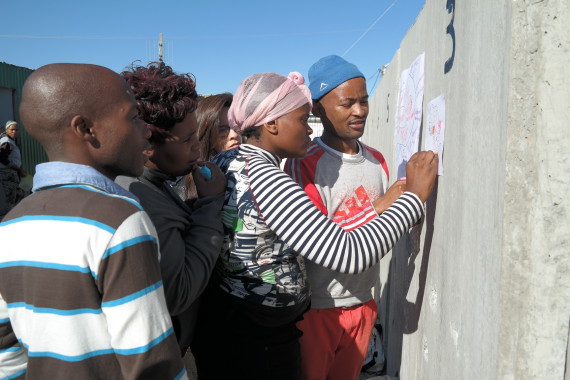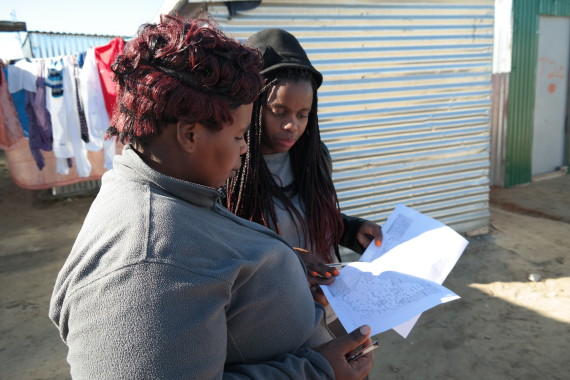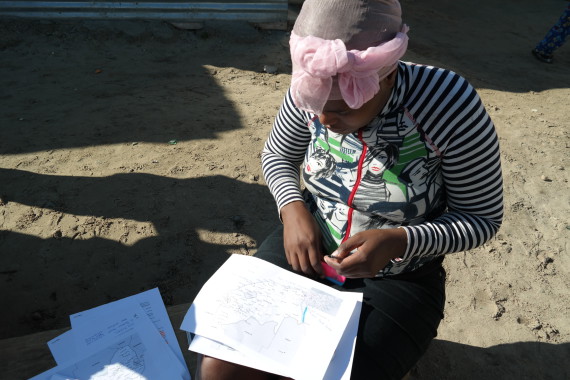By Sarah Cooper-Tognoli
This piece traces the individual migration stories of four informal settlement dwellers in Tambo Square, a settlement affiliated to the Informal Settlement Network (ISN). It is a product of creative initiative taken by an intern of Shack/ Slum Dwellers International (SDI) who worked with the South African SDI Alliance. Drawing on the difference between the Xhosa terms for ‘where are you staying/living now’ (Uhlala phi?) and ‘where are you from’ (Uvela phi?), the migration map sheds light on personal experiences of migration and documents the broader history and challenges that affect the residents of a particular informal settlement.
My map describes information gleaned from key informant interviews conducted in July 2015. The interviews revealed the movement histories of Norma, Nkosikhona, Tebaho, and Patricia (Phumela) — four residents aged 27-30 living in Tambo Square, an informal settlement in the township of Mfuleni, Cape Town. The interviews were conducted as part of my work researching migration for Shack Dwellers International (SDI). The interviewees were identified in the process of conducting a Focus Group Discussion (FGD) with the Tambo Square community. I chose Norma, Nkosikhona, Tebaho, and Patricia (Phumela) not only because their stories were incredibly moving, but they showed me such warmth, openness, and kindness that I felt compelled to understand more and document their stories in a map.
As the title of my map suggests, “Uhlala phi (Where are you staying/living now)? Uvela phi (Where are you from)?” my work explores the movement histories of informal settlement residents and centers upon understanding where they were born, where they have lived, and where they are living now. Critically, it also delves into the underlying reasons for their movement, lived experiences throughout, challenges faced, what they define as their needs, as well as a timeline in years to ground this information.
During the FGD, produced and conducted in conjunction with representatives of the SA SDI Alliance, I gave Norma, Nkosikhona, Tebaho, and Patricia (Phumela) a map of South Africa and asked each of them to mark their birthplace/year and their movement history ending in Cape Town. The sheer act of sitting side by side and drawing on a map and the interaction this allowed created a rapport, or rather a connection that transcended the activity — I say this in truth at that cost of sounding cliche. In general, the map exercise and the follow-up questions involved were guided by both my conversation with Dr. Owen Crankshaw (Sociology Department, UCT) and Dr. Borel-Saladin (post-doctoral fellow at the African Centre for Cities, UCT) at the University of Cape Town, as well as Dr. Owen Crankshaw’s ”A Simple Questionnaire Survey Method for Studying Migration and Residential Displacement in Informal Settlements in South Africa” (SA Sociological Review, 1993). This research revealed gaps in the information produced by migration surveys of informal settlements, which my work attempts to bridge.

Migration Workshop and Focus Group Discussion with Tambo Square residents, Sarah Cooper-Tognoli and CORC support staff

Nomaphelo, Bangiso, Tebgo and Patricia collect ideas and associations related to the idea of “movement” (migration)
According to Dr. Crankshaw and Dr. Borel-Saladin there is a paucity of data when it comes to where people originated (their ‘home home,’ — a term I have encountered in South Africa) and that residents of informal settlements often live in a nearby informal settlements before settling in their current place of residence. Thus, asking these residents where they lived before their current residence does not provide accurate information as to their origin (‘from from’). Therefore, one aspect of my focus was on birthplace (and year), movements from birthplace to current residence, and a timeline of these movements in years in order to chronologically contextualize them.
The movement histories of Norma, Nkosikhona, Tebaho, and Patricia corroborate this movement pattern with each having lived in another informal settlement in Mfuleni before moving to Tambo Square. My interviews with all four residents reveal that three out of four originate from the Eastern Cape. This trend in internal migration (by far the dominant form of migration in South Africa) from the Eastern Cape to the Western Cape was also supported by my interview with Nkokheli Ncambele — the Informal Settlement Network* (ISN) Coordinator for the Western Cape. As both a resident of Mfuleni, and whose job entails constant interaction with communities in Mfuleni, he holds considerable authority on the topic of urban migration histories. “The Informal Settlement Network (ISN) is a bottom-up agglomeration of settlement-level organisations of the poor at the city-wide scale in six South African municipalities, including Cape Town. ISN mobilises communities to engage government around security of tenure and better service delivery” (“Building Inclusive Cities” 2013/2014 Annual Report, 2014).
Overall, my map outlines the spatial, temporal and experiential trajectories of Norma, Nkosikhona, Tebaho and Patricia (Phumela). The map is displayed in the form of a layered circle broken into quadrants; at the center lies Tambo Square — each person’s current place of residence, and the current year. Corresponding colored lines represent each resident’s movement trajectory. For instance, if one follows Tebaho’s movement history, one starts at Tambo Square, and moves along the blue line encountering four dots (with a corresponding blue box informing the location, year, and reasons for his movement), and lastly arrives at Tebaho’s birthplace, and year. Thus, my interview questions (referred to above) — Where were you born? What year were you born? What year did you leave your birthplace? How old were you when you left? Why did you leave? Why did you come to Cape Town? — are answered. Nestled amongst this information (within Tebaho’s quadrant) is text that provides answers to further questions: Was your first urban residence in Cape Town? If not, where? Do you have a job? How do you feel about where you are living? Who do you live with/are you living with family? Do you have links to family in Cape Town, or larger South Africa? If so, do you visit, and how often? What are the needs you need met in terms of infrastructure and livelihood? Thus, one is able to read graphically the movement history of Tebaho, and the other three informal residents of Tambo Square. In general, as a timeline, the information closer to the circle center represents its relevance to the current year.
It should be noted that much of the information from Patricia (Phumela) is missing. Her interview was translated from Xhosa (unlike the others) and her information was less detailed. Regrettably, she was not available for a follow-up interview when I returned to Tambo Square. Nevertheless, I thought it was important to include Patricia (Phumela) for two reasons: firstly, the lack of information is both representative of the nature and time constraints of short-term field work — one does not always get the full story; secondly, many movement histories, and thus, stories of informal settlers, remain unknown, and Patricia is emblematic of that. In reality, Patricia’s movement history is surely as rich as Tebaho, and yet, it is unknown in this context.
In addition, I would have liked to have further explored the concept of ‘home’ in a more metaphorical sense by probing the issue of whether Tambo Square “feels like home.” In a follow-up interview with Tebaho his answer spoke volumes: ‘Do not think this is my home; think of this as a hiding so long as looking for economic sources. Hiding; not a home.’ As a colleague at CORC, a South African and native Xhosa speaker, points out “home” in Xhosa is where you were originally born; if you were born in the Eastern Cape and if your parents are from the Eastern Cape, that is your home. The implications for this sense of “home” for South Africa’s cities is both upsetting and intriguing.
In conclusion, my intention for this map is to display data in a way that does not detach it from the people it seeks to portray, but brings to light Norma, Nkosikhona, Tebaho, and Patricia’s journeys, (and more precisely, a bit of their lives) as well as the rich influences of migration on residents of informal settlements. I hope that the way I have portrayed their stories conveys the great respect I have for their courage amidst immense struggle and their willingness to share their stories with me.
Sarah Cooper-Tognoli is an MA candidate for International Affairs at The New School, New York.





